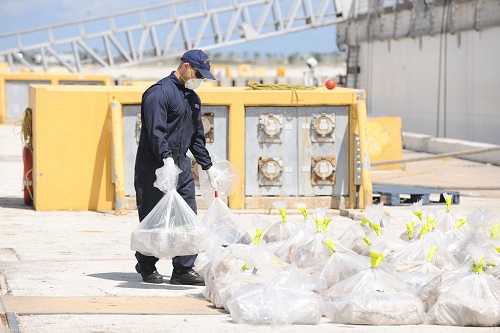CGN photo
By
Ricardo Swire
The Netherlands is Europe’s second largest cocaine entry point after Spain. The trend reflects Rotterdam’s importance as Europe’s largest port and its cultural ties to several Caribbean islands. Dutch Antilles and Aruba’s Coast Guards routinely seize large amounts of cocaine, several parallel streams flowing to Europe. Commercial air couriers, often directed by West African criminal organizations, fly to Europe from various intermediate Caribbean territories. Colombian Cartels, in collaboration with Dominican Republic crime syndicates, additionally exploit commercial airlines.
The mega drug consignments, stored aboard “Mother Ships,” are transported to shore by small coastal vessels. Such watercraft transits select Caribbean islands. Europe’s primary maritime points of entry are Spain and the Netherlands. Spain’s association is proximity and cultural links. The Netherlands chosen for its large busy ports. Caribbean internal security intelligence officials are aware trafficking cartels in the Dominican Republic, Bolivia, Colombia, Mexico and Peru reduce their cocaine’s potency with adulterants before export.
European law enforcement agencies have conducted “upstream’ work” that assists South American counterparts with seizures, before drug consignments depart the continent. In one counternarcotics enforcement effort Dutch Navy resources intercepted four point two tons of cocaine aboard a cargo vessel sailing under a Panamanian flag. The ship voyaged from Venezuela to Europe. The same year Dutch counterdrug agents intercepted six point eight tons of cocaine transiting the Netherlands. Belgium’s counternarcotics agents reported increased cocaine confiscations in contrast to Europe’s overall trend. Belgium had fourth most cocaine seizures in Europe.
2007 interdictions increased from two point five tons to four point six tons in 2009. Between 2008 and 2009 French law enforcers seized Europe’s second largest annual cocaine total. A considerable factor was traffic diversion to Belgium, notably the Port of Antwerp. In October 2013 Europol’s director announced a sophisticated cyber attack on the Belgium port. For two years, Dutch drug traffickers controlled container movements and placements at the Port of Antwerp. In one scenario, nearby in the Limburg province, a truck leaving the Port of Antwerp with a container of cocaine was attacked by unidentified gunmen armed with AK47 assault rifles.
In the Port’s electronic assault Belgium headquartered digital henchmen, recruited by the drug trafficking syndicate, used the “new business model of organized crime” to infiltrate Port of Antwerp’s Information Technology system. Denial-of-service attacks provided traffickers with access to private Port data pinpointing shipping container locations and security details. Staff members of two container companies within the Port facility were emailed malicious software via social engineering phishing assault. The employees’ opened mail allowed Cartel hackers remote computer entry.
A defensive firewall was installed after Port security protocols detected the first electronic infiltration. In the cyber-attack’s second phase hackers illegally entered the Port premises and physically fitted “key-logging devices” on select computers to capture typed data. After factoring in compiled intelligence law enforcement units in Belgium and Holland executed simultaneous raids. Computer hacking equipment, large quantities of cocaine, heroin, a guns cache and suitcase containing €1.3 million cash were confiscated.
Ricardo Swire
Ricardo Swire is the Principal Consultant at R-L-H Security Consultants & Business Support Services and writes on a number of important issues.



No Comments Yet!
You can be first to comment this post!